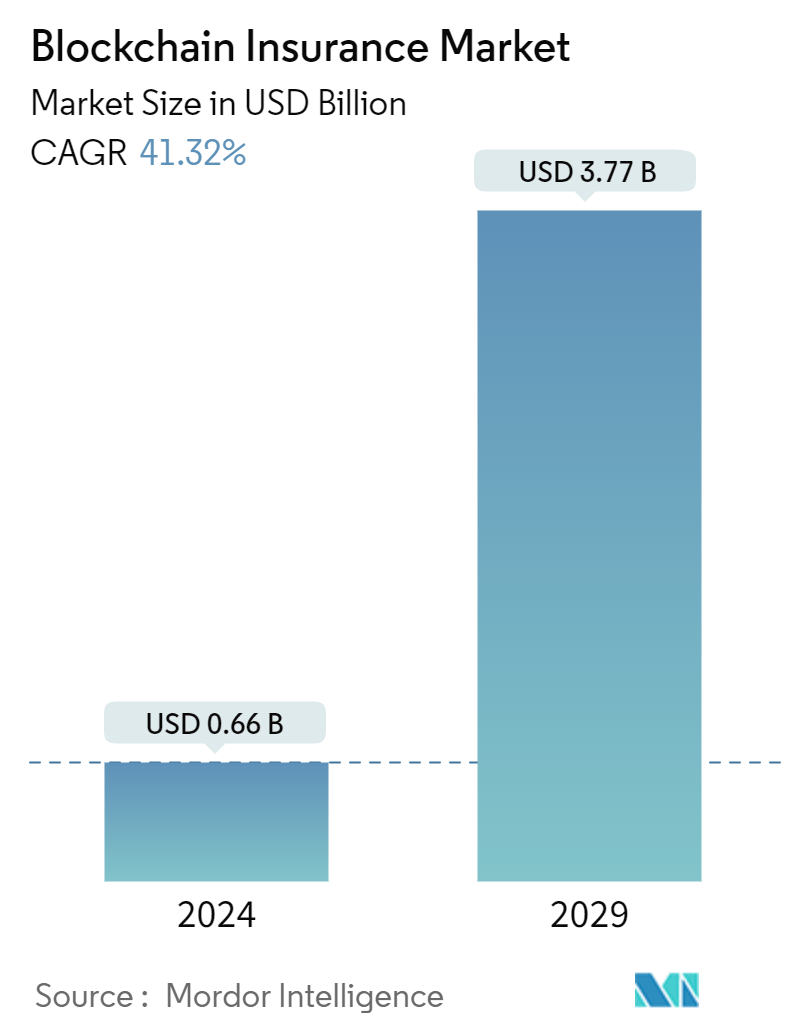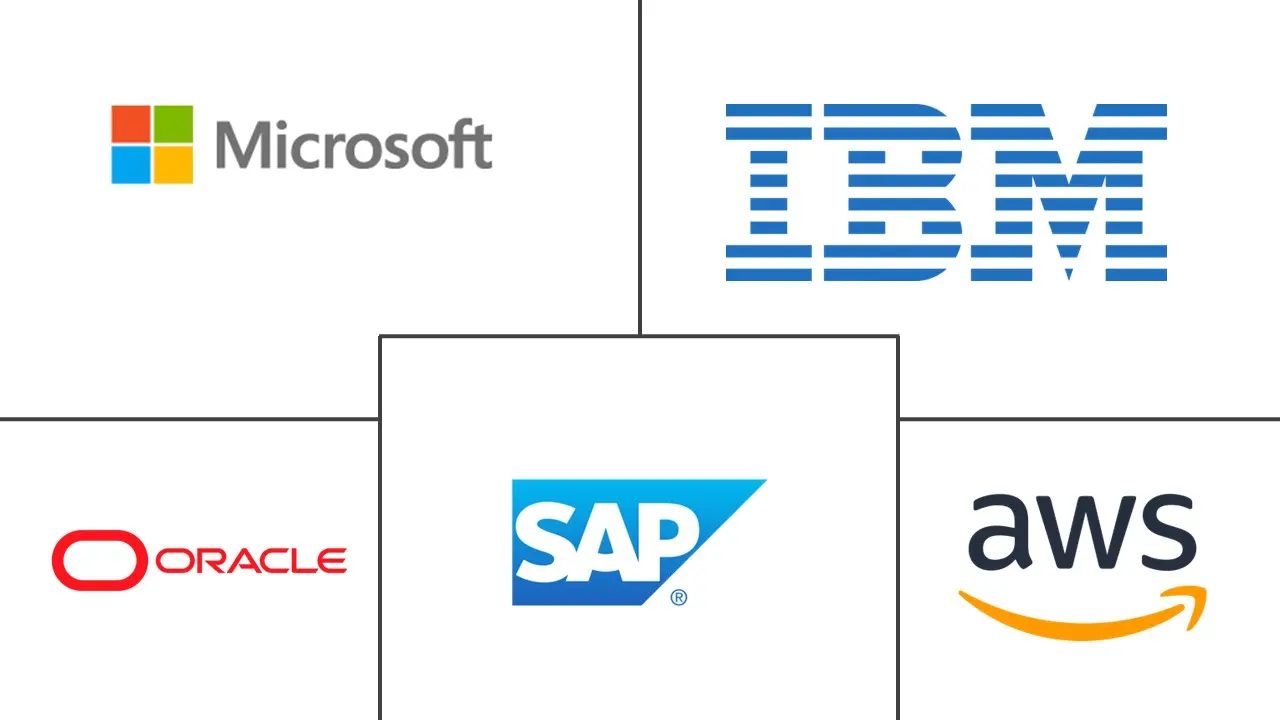Market Size of Blockchain Insurance Industry

| Study Period | 2019 - 2029 |
| Market Size (2024) | USD 0.66 Billion |
| Market Size (2029) | USD 3.77 Billion |
| CAGR (2024 - 2029) | 41.32 % |
| Fastest Growing Market | Asia Pacific |
| Largest Market | North America |
| Market Concentration | High |
Major Players
*Disclaimer: Major Players sorted in no particular order |
Blockchain Insurance Market Analysis
The Blockchain Insurance Market size is estimated at USD 0.66 billion in 2024, and is expected to reach USD 3.77 billion by 2029, growing at a CAGR of 41.32% during the forecast period (2024-2029).
Blockchain technology is helping the insurance business in drastically changing operations, offering a diverse range of advantages like lower costs, improved customer experiences, increased productivity, increased transparency, and more.
- Insurance fraud can be eradicated by insurers using blockchain insurance claims. Because of the immutable property of blockchain, moving insurance claims into a shared ledger among insurance companies that cannot be altered will eventually eliminate fraud. According to the FBI, it is estimated that non-health insurance fraud costs the economy more than USD 40 billion annually. As a result of higher premiums, insurance fraud costs the typical American family between USD 400 and USD 700 annually. The increase in the number of insurance frauds is expected to drive the deployment of blockchain in the insurance industry.
- The insurance market is integral to the global economy, covering personal and business risks. According to the International Monetary Fund, the market size of non-life insurance in the Gulf Cooperation Council countries was predicted to increase from USD 22.7 billion in 2021 to USD 26.5 billion in 2026. In comparison, the market size of life insurance in the GCC was anticipated to grow from USD 3.8 billion in 2021 to USD 4.6 billion in 2026 and is expected to have lucrative opportunities for growth.
- Blockchain technology can speed up banking and lending processes while lowering counterparty risk, issuance, and settlement times. It enables real-time financial verification, authenticated documentation, and KYC/AML data, lowering operational risks. Real-time payments against assets are made possible by blockchain technology, which results in significant cost reductions. The usage of blockchain technology for payment applications is one of the current trends.
- To transform payments, market players are developing advanced blockchain technologies. In the insurance industry, using blockchain for payments helps lower risks while enhancing efficiency and transparency in payment processes. Several institutions worldwide have developed blockchain-based payment networks, including Banco Masventas (Argentina), MUFG, and Taipei Fubon Commercial Bank.
- The vendors in the blockchain market in the insurance industry are moderately consolidated with an array of different application purposes. However, major vendors such as Dell, Amazon Web Services Inc., Oracle Corporation, and many more are highly preferred blockchain product/solution providers across various insurance applications. To meet the various demands of the customers, blockchain firms are providing new solutions.
- Additionally, it is introducing a second product called crypto-native prisoners, a new captive offering from Nayms. Large corporations that establish a subsidiary to provide insurance to group firms frequently utilize captive insurance. Large blockchain protocols now routinely reserve a treasury fund to be utilized in the event of a hack or other problem in the crypto realm.
- However, the applications of blockchain technology are still in their infancy across several industry verticals. Even if the insurance sector has demonstrated a favorable trend in adopting technology, there is still more that needs to be done to raise awareness of distributed ledger technology (DLT) and its many potential applications in the insurance sector. One of the biggest problems is the lack of knowledge, which might restrict the growth of the studied market.
Blockchain Insurance Industry Segmentation
Blockchain technology is a robust database mechanism that enables the transparent sharing of information within a corporate network. We can build an unalterable database for monitoring payments, orders, accounts, and other transactions using blockchain technology. The system includes mechanisms for preventing unauthorized transaction entry and ensuring consistency in the shared view of these transactions.
Within insurance, the claims and finance functions are high-value areas where blockchain could be beneficial, especially when you look at processes that need ongoing reconciliation with external parties. Insurers and customers waste a lot of time verifying their documents and identities. This can be reduced with a blockchain platform that can talk to other blockchain platforms to verify the identity of the user. The market includes various standalone services in the insurance sector, such as smart contracts, identity management, and fraud detection, death and claims management, and governance, risk, and compliance management.
The blockchain market in the insurance industry is segmented by deployment (on-premise, cloud-based), type (public, private), application (GRC management, smart contracts, financial management, identity management & fraud detection, death and claims management, and other applications), geography (North America (United States, Canada), Europe (United Kingdom, Germany, France, and Rest of Europe), Asia Pacific (China, Japan, Singapore, Australia, and Rest of Asia Pacific), and rest of the world.
The market sizes and forecasts are provided in terms of value (USD) for all the above segments.
| By Deployment | |
| On-premise | |
| Cloud Based |
| By Type | |
| Public | |
| Private |
| By Application | |
| GRC (Governance, Risk and Compliance) Management | |
| Smart Contract | |
| Financial Management (Payments) | |
| Identity Management & Fraud Detection | |
| Death and Claims Management | |
| Other Applications |
| By Geography*** | ||||||
| ||||||
| ||||||
| ||||||
| Latin America | ||||||
| Middle East and Africa |
Blockchain Insurance Market Size Summary
The blockchain insurance market is poised for significant growth, driven by the technology's ability to transform insurance operations by enhancing efficiency, transparency, and customer experience. Blockchain's immutable nature offers a robust solution to combat insurance fraud, a persistent issue that incurs substantial costs. The technology's application in creating shared ledgers for claims processing is expected to reduce fraud significantly, thereby lowering premiums for consumers. The insurance sector, a critical component of the global economy, is increasingly adopting blockchain to streamline processes such as banking and lending, which benefits from real-time financial verification and reduced operational risks. Major players in the market, including Dell, Amazon Web Services, and Oracle, are leading the charge by providing innovative blockchain solutions tailored to the insurance industry's diverse needs.
Despite the promising outlook, the adoption of blockchain technology in insurance is still in its early stages, with awareness and understanding of distributed ledger technology remaining challenges. On-premise solutions offer enhanced data control and security, while cloud-based technologies provide flexibility and cost-effectiveness. The market is witnessing a trend towards developing advanced blockchain payment systems, which enhance efficiency and transparency in payment processes. The insurance industry is also seeing the introduction of new products, such as crypto-native prisoners, to address specific market needs. However, the market's growth is tempered by concerns over data security and the need for significant investment in on-premise solutions. As the industry continues to evolve, the integration of blockchain technology is expected to offer substantial opportunities for growth and innovation.
Blockchain Insurance Market Size - Table of Contents
-
1. MARKET INSIGHTS
-
1.1 Market Overview
-
1.2 Industry Attractiveness - Porter's Five Forces Analysis
-
1.2.1 Threat of New Entrants
-
1.2.2 Bargaining Power of Buyers/Consumers
-
1.2.3 Bargaining Power of Suppliers
-
1.2.4 Threat of Substitute Products
-
1.2.5 Intensity of Competitive Rivalry
-
-
1.3 Technology Snapshot
-
1.4 Impact of COVID-19 and Macro Economic Trends on the Market
-
-
2. MARKET SEGMENTATION
-
2.1 By Deployment
-
2.1.1 On-premise
-
2.1.2 Cloud Based
-
-
2.2 By Type
-
2.2.1 Public
-
2.2.2 Private
-
-
2.3 By Application
-
2.3.1 GRC (Governance, Risk and Compliance) Management
-
2.3.2 Smart Contract
-
2.3.3 Financial Management (Payments)
-
2.3.4 Identity Management & Fraud Detection
-
2.3.5 Death and Claims Management
-
2.3.6 Other Applications
-
-
2.4 By Geography***
-
2.4.1 North America
-
2.4.1.1 United States
-
2.4.1.2 Canada
-
-
2.4.2 Europe
-
2.4.2.1 United Kingdom
-
2.4.2.2 Germany
-
2.4.2.3 France
-
-
2.4.3 Asia
-
2.4.3.1 China
-
2.4.3.2 Japan
-
2.4.3.3 Singapore
-
2.4.3.4 Australia and New Zealand
-
-
2.4.4 Latin America
-
2.4.5 Middle East and Africa
-
-
Blockchain Insurance Market Size FAQs
How big is the Blockchain Market in the Insurance Industry?
The Blockchain Market in the Insurance Industry size is expected to reach USD 0.66 billion in 2024 and grow at a CAGR of 41.32% to reach USD 3.77 billion by 2029.
What is the current Blockchain Market in the Insurance Industry size?
In 2024, the Blockchain Market in the Insurance Industry size is expected to reach USD 0.66 billion.

